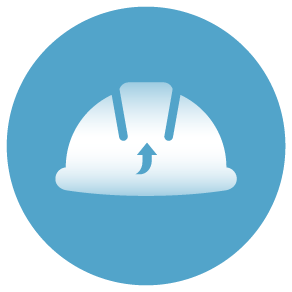The CLP Group’s HSE Improvement Strategy is based on five pillars, they are:
Uplifting the safety culture
Rethinking risk
Involving stakeholders
Maintaining a healthy and engaged workforce
Ensuring environmental sustainability.
Each pillar emphasises a key fundamental principle for effective HSE management. It aims to uplift the Group’s safety culture across all operating regions, promote more proactive risk management, and engage employees, contractors and other key stakeholders in collectively implementing changes to improve safety performance.
As part of Enterprise Risk Management, consistent standards continued to be implemented across the Group for risk management, including the identification of risks and opportunities.
Read more on CLP's Health, Safety, Security and Environment management Download an overview of the safety and environmental management systems for CLP’s assets Goals and targets
CLP is committed to ensuring all activities and operations result in zero harm for employees, contractors, customers and the public. The Group’s goal is zero fatalities and zero serious injuries for employees and contractors. CLP aspires to meet this target as part of its commitment to creating a healthy and safe workplace.
Monitoring and follow-up
The CLP Safety Performance Monitoring and Reporting Standard sets out the safety performance indicators and requirements of safety data reporting. It utilises indicators to show trends which may require more attention to prevent an incident from occurring.
Safety performance is reported internally on a monthly basis. Safety performance data is collected and presented in the monthly meetings between the Group Operations Leadership Team and the Global HSE Team. The data is also reported on a quarterly basis to the Group Health, Safety, Security and Environment (HSSE) Committee Meeting which is chaired by the Chief Executive Officer.
CLP’s revamped Incident Management Standard sets out the minimum requirements for the implementation and maintenance of a safety incident management system across the Group. In the event of a major incident, the CLP Group Incident Investigation Panel (IIP) and Investigation Report Format Standard are followed. The IIP, chaired by senior members of staff from outside the business unit in which the accident occurred, conducts a thorough investigation. The IIP’s reports are critically reviewed by the Group Chief Operating Officer and the regional Managing Director. The intention is to identify root causes and contributing factors in relation to every incident and ensure they do not occur again.
Training and awareness
Personnel will only be asked to do work in areas in which they are deemed capable and competent to perform their roles. This requires the careful selection, placement, training, ongoing competency assessment and authorisation of employees, with third-party independent assessment where appropriate. A system is in place to identify and deliver the training necessary to ensure an individual's competence and knowledge in understanding the hazards, risks and control measures associated with their work.
At the asset level, employees have the flexibility to structure their own Health and Safety organisations and to design more specific approaches in providing relevant health and safety training, as well as monitoring the percentage of contractors who have undertaken their training. Safety training requirements are in all contracts and all contractors are expected to undergo safety training relevant to their duties. Spot checks are conducted to ensure compliance.
Continuous improvement
Thorough investigations are conducted into all incidents that have the potential to cause serious injuries. The aim is to identify the root causes. CLP is also committed to understanding how decisions and actions would be made by employees at a particular point in time of their work. CLP is committed to learning from those closest to the work, to understand their challenges and respond by maximising the use of passive systems of defence, where possible.
CLP is committed to ongoing efforts to find new and better ways of working, by learning from investigations into incidents, as well as the adoption of best practices. For instance, the Group conducted a significant overview of its operations which involve underwater diving, with the express goal of eliminating such activities where possible. Major progress has been made in both the adoption of technology and the use of redesigned systems and equipment. In addition, principles for Human and Organisational Performance were supported through both leadership training and through less formal channels to help support their uptake and set expectations for all levels of the organisation.








